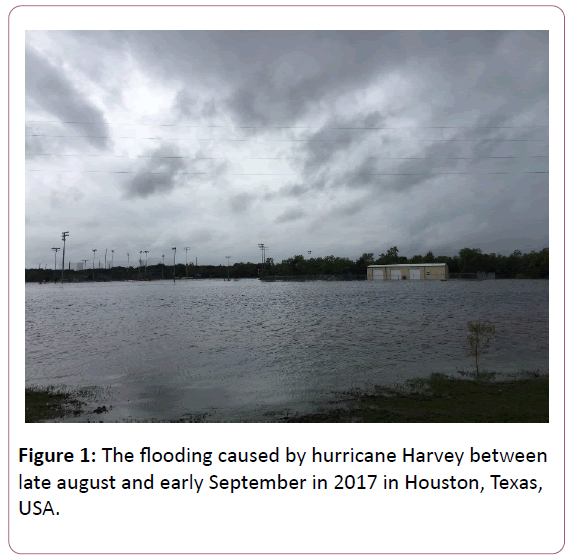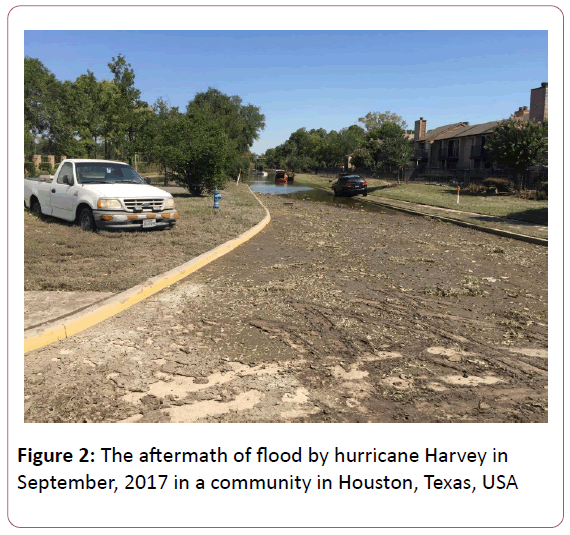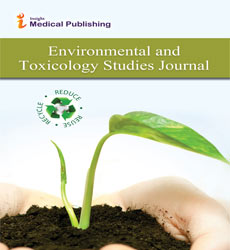Types of and Remediation Strategies to the Toxic Impacts of Flooding on Urban Environment and Public Health
Jianbang Du1, Qing Li2, Yachi Wanyan3 and Fengxiang Qiao2*
1Department of Environmental and Interdisciplinary Sciences, Texas Southern University, USA
2Innovative Transportation Research Institute, Texas Southern University, USA
3Department of Engineering, Texas Southern University, USA
- *Corresponding Author:
- Fengxiang Qiao
Co-director of Innovative Transportation Research Institute
Texas Southern University
3100 Cleburne Street, Houston, Texas, 77004, USA
Tel: 713-313-1915
E-mail: qiao_fg@tsu.edu
Received Date: November 6, 2017; Accepted Date: November 20, 2017; Published Date: November 30, 2017
Citation: Du J, Li Q, Wanyan Y, Qiao F (2017) Types of and Remediation Strategies to the Toxic Impacts of Flooding on Urban Environment and Public Health. Environ Toxicol Stud J. 1:4.
Abstract
Flooding is a natural disaster that may have adverse impacts on many aspects such as the environment, agriculture, public safety and health, and urban development. There are four types of flooding: groundwater, fluvial, pluvial, and coastal. The flooding resulted from intense raining may cause serious intangible losses. The bacteria spreading mold growth, chemical toxins, and carcinogens leaking caused by flooding could influence human and animal’s health in either acute or chronic manners. This paper synthesizes types of health and environmental hazards reported from several severe urban flooding events. Bacteria, especially Escherichia coli (E. coli), chemical toxins and carcinogens (heavy metal and organic toxins) that are contained in the flood water, and mold growth could influence human and animals’ health, and cause long lasting losses, which would be very hard to recover. Macroscopic strategies to prevent flooding and therefore its toxic impacts include the development of Sponge Cities, Green Roofs, and flood plains and overflow areas. Technical treatments to remediate the toxic impacts after flooding include: boil water thoroughly before consumption, drying out houses and well treating carpet and porous surfaces, frequent screening water body, and treating water via the supported-epoxidized carbon nanotube.
Keywords
Escherichia coli; Flooding could; Environment; Civilization of human societies
Type of Flooding and Impacts in Urban Area
Flooding as a disaster
Flooding is one of the deadliest natural disasters that influences the evolvement and civilization of human societies. One of the deadliest natural disasters recorded in history occurred in August 1931 in China. During that flooding, the Yellow River completely inundated 34,000 square miles, and partially flooded 8,000 square miles of land. It left 80 million people homeless and killed 850,000 to 4 million persons by estimation [1]. One worldwide record shows that, there were 539,811 deaths, 361,974 injuries, and 2,821,895,005 people affected by floods between 1980 and 2009 on the earth [2]. Other inconsistent reports suggest that, such affected population is underestimated, particularly the injured ones. During the recent flooding caused by hurricane Harvey between late August and early September in 2017, more than fifteen trillion gallons of water were dropped in Houston area, and resulted total loss of $160 Billion [3]. Figure 1 shows the influenced buildings and submerged roads during Harvey flood in 2017. In the modern society, the impacts of flooding are even continuously worse due to population increase, economic growth, and climate change [4].
Types of flooding
There are mainly four types of flooding: (1) groundwater, (2) fluvial, (3) pluvial, and (4) coastal. Flash growth of groundwater water table can trigger the groundwater flooding. Rising groundwater mostly lead to non-polluted water flooding on the basement. River overflow is the cause of the fluvial floods, the direct damage of which involves the potential of high water levels and fluid velocities. The level of contamination in fluvial flood water is correlated to the catchment characteristics, and subjected to the land use types of the flooding area. For example, hazardous chemicals are usually found in an industrial area, in which the contamination caused by flooding could be more severe than in other areas, such as residential areas. The flood could also contain building and rock debris from the upstream, which can increase vulnerability to flooding by influencing human and urban infrastructures.
The pluvial flooding is caused by the overloading of drainage systems during intensive rainfall, such as the consequence of tropical storm or long lasting intense raining. One of the critical aspects of the pluvial floods is that, the flood water can contain infectious diseases, especially when it is combined with the sewer systems.
The coastal flooding is caused by the rising of sea level as result of tidal surges and waves. The coastal flooding may induce the risk of high water level and strong water power like fluvial flooding. In particular, the sea water is more corrosive, which would cause higher risk of structural and electrical damage. However, the coastal flooding has lower risk of infectious disease consequences [5].
Urban flooding and its impacts
Urban flooding is the overspread of water on land or property in a civilized environment caused by rainfall overwhelming the capacity of drainage systems, such as storm sewers and reservoirs. The most important aspect in urban flooding is a condition characterized by its long lasting and systemic impacts on communities and environments. Deforestation and the increasing proximity of large populations to coastal areas, river basins and lakeshores may significantly increase the risks of catastrophic losses due to flooding [2]. Large-scale developments of impermeable concrete and asphalt pavements inhibit drainage. The storm or river overflow is detained above the ground and could have a high runoff volume into other neighborhoods, rather than into the soil [6]. The impacts could affect the communities regardless whether they are located within the floodplains or nearby water body [7].
The assessment of damages caused by floods could be classified into two levels: (1) economic loss assessment, and (2) financial loss assessment. The economic loss assessment is a macro scale measurement by considering the national economic impacts, instead of only considering the influenced areas of the flood. The financial loss assessment is a micro scale measurement by considering the loss at an individual household level. There are mainly four types of flooding damages illustrated in (Table 1).
| Type of Flooding Damage | Examples |
|---|---|
| Direct tangible loss | Structural damage, vehicle damage, livestock and crops |
| Indirect tangible damage | Interruption of business and transport, household evacuation |
| Direct intangible loss | Lives injuries, diseases, environmental damage |
| Indirect intangible loss | Stress and anxiety, land value reduction and loss of community |
Table 1: Types of flooding damage and loss [5].
Intangible loss is often associated with the health and environmental issues for urban areas due to a high density of population, which leads to high risk of disease spreading through water supply and sewerage system [8].
Flooding Related Health and Environmental Hazards
The flood contains large number of hazards to the environment and human health. Great variety of contaminants can present in the floodwater including coliform bacteria, mold, chemical toxins and carcinogens. During the flooding such as pluvial flooding, there is an overloading in urban drainage systems caused by severe rainfall, such as the consequence of tropical storm or long lasting intense raining. The drainage system and sewer system are usually the habitat for various infectious bacteria. Toxins released from an industrial area and/or an area nearby could influence the ecosystem dramatically. (Figure 2) shows the aftermath of hurricane Harvey flood in a Houston community.
Bacteria
Bacteria during flood events could fatally influence human and livestock health and the consequences are long lasting [2]. One family of the critical bacteria in flood water is the Coliform bacteria such as the E. coli, which are anaerobic bacteria that are commonly found in the lower intestine of warm blooded organisms. The virulent strains of E. coli can cause gastroenteritis, urinary tract infections, neonatal meningitis etc. [9]. Public water systems are required to deliver drinking water that there should be no more than one sample out of 40 samples with the total coliform positive [10]. However, in the flooding situation, the sewer plant may have a malfunction or sewer plant discharge untreated or partially treated waste.
In late August 2017, Houston was flooded by hurricane Harvey. Three water samples from sewer plants were all coliform positive (57,000 CFUs (Colony-forming units), 43,000 CFUs, 4500 CFUs, respectively) [11]. Based on the Environmental Protection Agency (EPA) criteria, the recreational water quality ranges from 100 to 410 CFUs [12]. This shows a mixture of sewage in water [11]. Some other bacteria including Necrotizing fasciitis caused one dead in Houston during Harvey’s landfall [13].
The V. vulnificus, V. parahaemolyticus bacteria caused Vibrio illness in the New Orleans flood after hurricane Katrina. Zika viruses are spread out by mosquito’s habitat in the Houston Harvey flood water [14]. Although natural processes like sunlight and oxygen could break down some of the bacteria [11], this hazard can influence human and livestock’s health for extended period.
Mold
Mold is a fungus that grows in the form of multicellular filaments that cause biodegradation of natural materials [15]. When human is exposed to large quantities of mold, there could be a health issue such as the allergic reactions and respiratory problems. Some mold could even produce mycotoxins that can raise severe healthy risks to human and animals [16]. The mold growth after hurricanes is extremely common and widespread. This process usually only needs a couple of days. Studies showed that, extensive mold growth in New Orleans houses were reported even not on the floodplain affected by hurricane Katrina. By a research of the landfall of hurricane Katrina in New Orleans in late August in 2005, the visible mold growth occurred in 44% of flooded houses and 16% of the houses had mold coverage more than a half. The residents spent an average of 18 hours on doing heavy cleaning. Among those, 38% of households reported using an N-95 or other respirator [17]. Report show that, several previous healthy people who did not have respiratory issue could develop asthma by the infection of mold in the Houston Harvey flood in 2017 [18].
Chemical toxins and carcinogens
Chemical toxins and carcinogens regarding flooding includes heavy metals such as arsenic, lead, mercury, cadmium and organic chemicals such as organic solvent and oil waste. Heavy metals are commonly assumed to be highly toxic or damaging to the environment [19]. Chromium, arsenic, cadmium, mercury, and lead have the greatest potential to cause harm, due to their extensive uses, the toxicity of some of their combined productions and elemental forms, and their widespread distribution in the environment [20]. Some of the heavy metal oxide are carcinogenic for animals such as Vanadium pentoxide and some can cause DNA damage or kidney poison. Several certain organic chemicals can also be classified as carcinogens such as benzo[a]pyrene.
According to EPA, during 2017 Houston flood due to hurricane Harvey, at least 13 toxic waste sites were flooded or damaged, in which toxic industrial wastes have been leaked from petrochemical companies, acid compounds, solvents, and pesticides [21]. These hazardous chemicals could contaminate groundwater and spread over after joined bayous. Studies have identified significantly higher rates of cancer and respiratory illness among those who are living along the Ship Channel and San Jacinto River in Houston area [22]. Although the health effects of carcinogens and chronic toxins may not be revealed in a short period, the flood event would intensify such consequences.
Flooding Prevention and Remediation
There are several macroscopic strategies to prevent flooding and therefore its toxic impacts in urban areas. One of the typical examples is to establish a ‘Sponge City’ that can hold and drain water in a nature way, which is practicing in China now. The ‘Green Roofs’ that could contain more water and reduce the water runoff is another popular treatment in Europe. Another way is to create flood plains and overflow areas [23]. For example, there are two big reservoirs in Houston that are used to safeguard the main urban areas during flooding.
When a flood situation is unavoidable, several treatments can be used for eco-remediation purposes. To ensure the safety from E. coli of drinking water, it is recommended to boil the water for 3 minutes before consumption, so as to inactivate the E. coli in water [24]. To reduce the risk of mold, influenced houses should be dried out first, then remove and treat the carpet and porous surfaces [25]. To reduce the risk of chemical toxins and carcinogens, the influenced water body should be screened frequently. When there’s risk for any of the chemical toxins and carcinogens, nearby residents should be properly informed in advance. Some techniques were proposed to treat the toxins and carcinogens in water. For example, the supported-epoxidized carbon nanotube (SENT) can be used to improve water quality. Alagappan et al. [26] investigated that; 83,000 L of chemical contaminated water can be treated by 1 gram of SENT.
Conclusion
Based on the reviews and analysis above, bacteria (E. coli), chemical toxins and carcinogens (heavy metal and organic toxins) that contained in the flood water, as well as mold growth during flooding period could induce adverse impacts on human and animals’ health. These intangible losses are long lasting and hard to recover. Future research is needed with multipronged approaches that focus on long-term and sustainable solutions to increase urban areas’ resilience to flooding.
References
- Lotha G. Huang He floods (2016) Encyclopedia Britannica.
- Doocy S, Daniels A, Murray S Kirsch TD (2013) The Human Impact of Floods: a Historical Review of Events 1980-2009 and Systematic Literature Review. PLoS Curr pp: 5.
- Herriges D (2017) Houston isn't flooded because of its land use planning. Stong Towns. https://www.strongtowns.org/journal/2017/8/30/houston-hurricane-harvey-land-use
- Tanoue M, Hirabayashi Y, Ikeuchi H (2016) Global-scale river flood vulnerability in the last 50 years. Scientific Reports 6: 36021.
- Olesen L, Löwe R, Arnbjerg-Nielsen K (2016) Flood Damage Assessment- Literature review and recommended procedure. DTU.
- Booth DB, Leavitt J (1999) Field evaluation of permeable pavement systems for improved stormwater management. J Am Inst Plann 65: 314-325.
- Festing H, Copp C, Sprague H, Wolf D, Shorofsky B, et al. (2014) The Prevalence and Cost of Urban Flooding: A Case Study Of Cook County, IL. Center for Neighborhood Technology pp: 2-25.
- Dutta D, Herath S, Musiake K (2003) A mathematical model for flood loss estimation. J Hydrol (Amst) 277: 24-49.
- Ryan KJ, Ray CG (2004) Medical microbiology. McGraw Hill, 4, 370.
- Calabrese EJ (1989) Safe Drinking Water Act: CRC Press.
- Scutti S (2017a) Sewage, fecal bacteria in Hurricane Harvey floodwaters. CNN.
- EPA (2012) Recreational water quality criteria. US Environmental Protection Agency Washington, DC.
- Scutti S (2017b). Woman dies from flesh-eating bacteria from Harvey-flooded home. CNN. https://www.cnn.com/2017/09/01/health/houston-flood-water-contamination/index.html
- Firger J (2017) Infectious Diseases Could Sweep Across Texas as Harvey Floods Houston. Newsweek U.S Edition.
- Moore D, Robson GD, Trinci APJ (2000) 21st Century Guidebook to Fungi. Cambridge: Cambridge University Press.
- Empting L (2009) Neurologic and neuropsychiatric syndrome features of mold and mycotoxin exposure. Toxicol Ind Health 2: 577-581.
- Chew GL, Wilson J, Rabito FA, Grimsley F (2006) Mold and endotoxin levels in the aftermath of Hurricane Katrina: a pilot project of homes in New Orleans undergoing renovation. Environ Health Perspect 114: 1883.
- Welch A (2017) Mold a serious health risk in wake of Harvey's flooding. CBS NEWS.
- Duffus JH (2002) “Heavy metals a meaningless term? (IUPAC Technical Report). Pure Appl Chem 74: 793-807.
- Baird C, Cann M (2012) Environmental chemistry: Macmillan Higher Education.
- Chavez N (2017) Harvey aftermath: Region begins long road to recovery. CNN https://www.cnn.com/2017/09/03/us/houston-texas-flood-aftermath/index.html
- Hersher R (2017). In Texas, Concerns about Damage to Flooded Toxic Waste Sites. NPR. https://www.npr.org/sections/thetwo-way/2017/09/04/548490643/in-texas-concerns-about-damage-to-flooded-toxic-waste-sites
- Wavin (2016) 10 measures to prevent (urban) flooding. https://www.wavin.com/web/news/show-news-on-page/10-measures-to-prevent-urban-flooding-1.htm
- Rangel JM, Sparling PH, Crowe C, Griffin PM, Swerdlow DL (2005) Epidemiology of Escherichia coli O157: H7 outbreaks, United States, 1982–2002. Emerg Infect Diseases 11: 603
- FEMA (2010) Mold Can Be A Danger After Flooding. https://www.fema.gov/news-release/2010/09/22/mold-can-be-danger-after-flooding
- Alagappan PN, Heimann J, Morrow L, Andreoli E, Barron AR 2017 Easily Regenerated Readily Deployable Absorbent for Heavy Metal Removal from Contaminated Water. Scientific Reports 7.
Open Access Journals
- Aquaculture & Veterinary Science
- Chemistry & Chemical Sciences
- Clinical Sciences
- Engineering
- General Science
- Genetics & Molecular Biology
- Health Care & Nursing
- Immunology & Microbiology
- Materials Science
- Mathematics & Physics
- Medical Sciences
- Neurology & Psychiatry
- Oncology & Cancer Science
- Pharmaceutical Sciences


